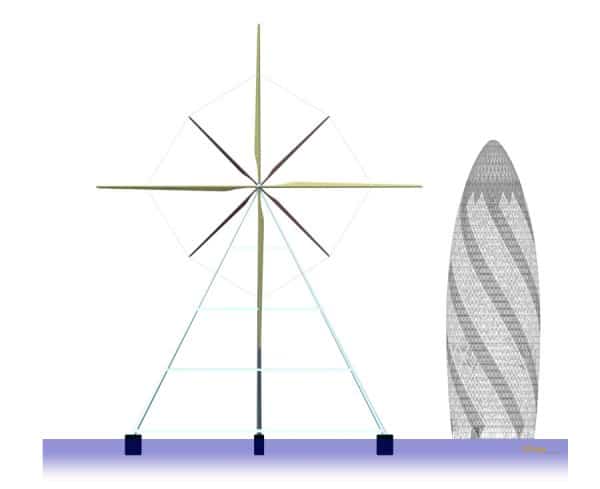
The future of wind energy could involve huge blades spanning half a kilometre that generate compressed air – which is then piped into giant, underwater balloons. That is the dream of Seamus Garvey, a mechanical engineer at the University of Nottingham in the UK, who envisages using the pressurized air to inflate the underwater balloons, nestling about 500 m below the surface of the sea. Electricity could then be generated by releasing the air to drive a set of turbines.
An important advantage of this arrangement, according to Garvey, is that several days’ worth of energy could be stored in the balloons while the wind is blowing – and then released when there is no wind. Garvey has just formed a university spin-out company called NIMROD Energy to commercialize the technology – dubbed Integrated Compressed Air Renewable Energy Systems (ICARES) – which he was been working on since 2006.
Rotating slowly
Garvey’s generator technology takes advantage of the fact that – for a given wind speed – huge turbines rotate more slowly than their smaller counterparts. While slow rotation makes electrical generation expensive, it is ideal for doing mechanical work. NIMROD’s turbine blades would be hollow and contain an internal piston. When a blade is pointing downwards, the piston is at the tip. But as the blade slowly lifts skywards, the piston falls through the cylinder, compressing air.
According to Garvey, such a scheme can only work if the blade rotates slowly enough that the centripetal force is not too large to pin the pistons to the ends of the blades. As a result, it would only be practical for turbines bigger than about 230 m in diameter. Indeed, he describes the 230 m-diameter turbine as the “baby”, with a giant, 500 m-diameter turbine being the ideal size.
Although building such massive turbines would be expensive, that wind is free still makes them economical in the long term, claims Garvey. He calculates that building a compressed-air system would be less than a third of the price of a conventional offshore wind system with the same generating capacity. Indeed, Garvey says that his system could be as cheap as a gas-turbine generator and have zero fuel costs.
What lies beneath
On the energy storage side of the scheme, Garvey says the ideal storage balloon would be about 20 m in diameter and anchored 500 m below the surface of the sea. He has already begun to test prototype “energy bags” and has received a €310,000 grant from the energy company E.ON to develop the technology further.
Garvey told physicsworld.com that a commercial undersea-storage system will be available by May 2011. However, he believes that it will take about 15 years to get the giant turbines up and running. In the meantime Garvey thinks the undersea bags could offer a convenient way of storing surplus energy from more conventional energy sources such as nuclear reactors, which are often located near the ocean.
Bags of potential
Compressed-air energy storage is not, however, a totally new idea. There are two facilities in the world – one in Germany and the other in the US – where surplus energy is taken off the electrical grid and used to pump air underground into disused salt mines.
According to Garvey, underwater storage has two advantages over such underground facilities. First, underwater storage is not limited to the locations of disused mines. Indeed, many coastlines – including southern Europe and the western US have deep water nearby. Second, the pressure in an undersea bag is constant, which means that turbines can be used to covert the air back into electricity in a relatively efficient way. An underground storage facility, by contrast, has a fixed volume, which means that the air pressure drops as air is released.
Garvey also believes that the bags could be used to store natural gas in maritime nations like the UK, boosting the country’s ability to ride out an interruption in imports of the fuel.
Jakob Mann, a wind-energy expert at Risø National Laboratory in Denmark, says that the storage technique is “worthwhile trying”, adding that cheap ways of storing surplus energy are much needed. However, he added that the undersea nature of scheme could boost the cost. “Offshore is always expensive,” he says.
Although Mann does not think locating the turbines in deep water will be a problem, he believes that building such massive compressing systems will be a challenge. Indeed, he suggests that the concept should first be trialled using electrical turbines that power electrical compressors.




